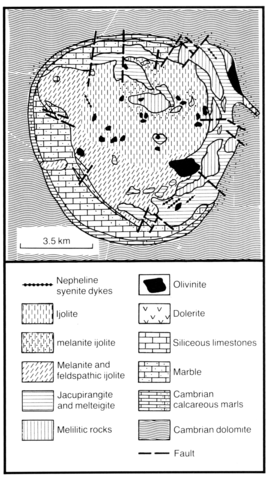stripes
This large complex intrusion, which was discovered by G.G. Moor and F.A. Starshinov in 1946, has since been investigated by many geologists. It has an area of 56 km2 and is situated 60 km east of the Guli intrusion, on the eastern bank of the Kotui River. The country rocks are lower and middle Cambrian dolomites. The massif has a concentric structure controlled by the distribution of the various compositionally contrasting intrusive phases, which, from early to late, are olivinite, melilite rocks, jacupirangite-melteigite and ijolite. They are all cut by dykes and veins of ijolite pegmatite, micro-ijolite, alkaline and nepheline syenites and calcite carbonatite. The olivinites are rocks of predominant olivine with small amounts of titanomagnetite and accessory clinopyroxene, perovskite, phlogopite, calcite, clinohumite, chromite and spinel. They are encountered as xenoliths within the later rocks. The melilite rocks are cut by later jacupirangite and melteigite and represented by monomineralic melilitolite, pyroxene uncompahgrite and pyroxene-nepheline turjaite. Olivine, titanomagnetite and accessory phlogopite, perovskite, garnet, calcite, apatite and amphibole are present in all rocks. The jacupirangite-melteigite series of rocks is found as a wide strip along all but the western periphery of the pluton and is also present as xenoliths in the later ijolites. The jacupirangites are composed mainly of clinopyroxene (augite and titanaugite); the melteigites also contain 20-30% of nepheline. Biotite, titanomagnetite, titanite, perovskite and accessory olivine, aegirine-augite, K-feldspar and phlogopite are generally present. A central stock having a diameter of 6.5 km and a small satellite west of the main intrusion are formed by ijolites. These rocks are composed of nepheline, pyroxene and accessory titanomagnetite, biotite-phlogopite, melanite, perovskite, titanite, apatite and calcite. Feldspathic ijolites are also developed. Ijolite pegmatites within melilite rocks are attributed to a separate sub-stage. They are phlogopite-bearing and of interest economically. Dykes and veins of nepheline syenite, in which the main rock-forming minerals are nepheline, K-feldspar and pyroxene, appear to be the last intrusive phase. They include accessory biotite, apatite, amphibole, titanomagnetite, titanite, cancrinite and albite. In some localities these rocks have been recrystallized and enriched in the agpaitic minerals eucolite, lovchorrite (mosandrite), lamprophyllite and others. All the rocks of the complex contain lens-like bodies and dykes of calcite carbonatite the main minerals of which are calcite, apatite, magnetite and phlogopite with accessory forsterite, aegirine-diopside, pyrrhotite and pyrochlore.
BUTAKOVA, E.L. and EGOROV, L.S. 1962. The Meimecha-Kotui complex of formations of alkaline and ultrabasic rocks. In Petrography of Eastern Siberia. 1: 417-589. Izd-vo AN SSSR, Moscow.
EGOROV, L.S. 1969. The melilite rocks of the Maimecha-Kotui province. Nedra, Leningrad. 247 pp.
EGOROV, L.S. 1991. Ijolite carbonatite plutonism (case history of the Maimecha-Kotui complexes northern Siberia). Nedra, Leningrad. 260 pp.
MOOR, G.G. 1957. The differentiated alkaline intrusives of the northern margin of the Siberian Platform (the right bank of the lower stream of the Kotui river). Izvestiya Akademii Nauk SSSR, Seriya Geologicheskaya, 8: 400-52.
PROCHOROVA, S.M., EVZIKOVA, N.Z. and MICHAILOVA, A.F. 1966. Phlogopite-bearing rocks of the Maimecha-Kotui province of ultrabasic alkaline rocks. Trudy Nauchno-Issledovatel'skogo Instituta Geologii Arktiki, Leningrad 140: 1-196.

